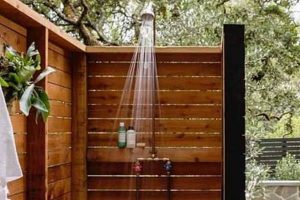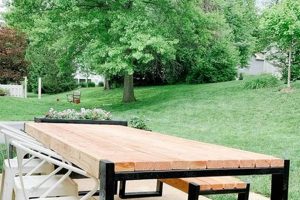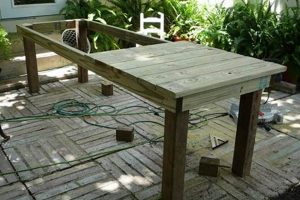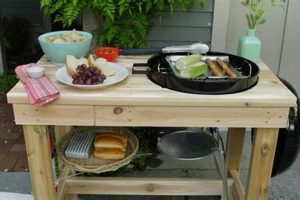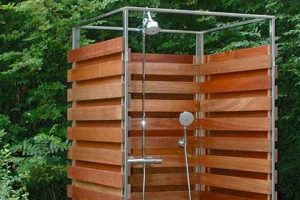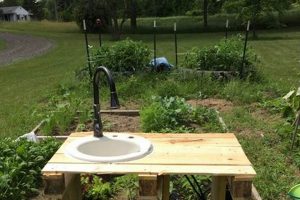The central concept involves the construction of a structure designed to support a television in an exterior environment, utilizing readily available materials and individual craftsmanship. This commonly entails creating a weather-resistant platform or cabinet to house and protect a television set while providing an optimal viewing angle in an outdoor setting. An example would be building a wooden frame with a protective covering to shield the television from sun, rain, and other environmental factors.
Such constructions offer a cost-effective alternative to purchasing pre-manufactured outdoor entertainment units. They allow for customization to perfectly fit specific spaces and aesthetic preferences. Historically, adapting indoor furnishings for outdoor use was commonplace. However, the increasing availability of weather-resistant materials and designs has led to a rise in dedicated outdoor entertainment areas and, consequently, greater interest in self-made solutions.
The following sections will explore essential considerations for planning and executing this type of project, including material selection, design principles, weatherproofing techniques, and safety precautions to ensure the longevity and functionality of the finished structure.
Essential Considerations for Outdoor Television Enclosures
The following guidelines offer critical considerations for designing and constructing a durable and functional structure to house a television in an outdoor setting.
Tip 1: Material Selection is Paramount: Prioritize weather-resistant materials such as treated lumber, marine-grade plywood, or powder-coated aluminum. These choices minimize degradation from moisture, sunlight, and temperature fluctuations. For example, using cedarwood provides natural resistance to rot and insect infestation.
Tip 2: Plan for Adequate Ventilation: Enclosed spaces can trap heat, potentially damaging electronic components. Incorporate ventilation strategies such as strategically placed vents or fans to facilitate airflow and regulate temperature. An example includes installing exhaust fans in the upper section of the enclosure to draw out warm air.
Tip 3: Implement Robust Weatherproofing: Protect the television from the elements by employing effective weatherproofing techniques. This includes applying sealant to all joints and seams, using a waterproof membrane for the enclosure’s exterior, and ensuring a tight seal around the television’s screen. A practical application involves using a marine-grade sealant to prevent water intrusion at all connection points.
Tip 4: Design for Cable Management: Organize and protect cables to prevent damage and ensure a clean aesthetic. Implement a cable management system that includes conduit or cable ties to keep wires neatly bundled and away from potential hazards. For instance, running cables through a PVC pipe provides physical protection and a tidy appearance.
Tip 5: Consider Viewing Angle and Sun Glare: Optimize the viewing experience by carefully considering the television’s placement and orientation. Position the structure to minimize sun glare and ensure a comfortable viewing angle from common seating areas. A retractable awning or strategically placed shade can mitigate sun glare.
Tip 6: Ensure Structural Stability: The enclosure must be structurally sound to support the weight of the television and withstand wind loads. Employ sturdy construction techniques and appropriate fasteners to ensure stability. Reinforcing corners with metal brackets can significantly enhance structural integrity.
Tip 7: Prioritize Electrical Safety: Ensure all electrical connections are properly grounded and protected from moisture. Utilize weatherproof electrical boxes and GFCI outlets to minimize the risk of electrical shock. Hiring a qualified electrician for the electrical work is strongly recommended.
Effective planning, careful material selection, and diligent construction are crucial for creating a safe, durable, and enjoyable outdoor entertainment experience. By focusing on weather resistance, ventilation, cable management, and structural integrity, a long-lasting and functional outdoor television enclosure can be realized.
The following conclusion will summarize the key benefits and implications of investing time and resources into such a project.
1. Weatherproof Material Selection
Weatherproof material selection is a foundational aspect of any successful outdoor television enclosure. The prolonged exposure to environmental elements necessitates careful consideration of material properties to ensure the longevity and functionality of the structure. The selection directly impacts the overall durability and resistance to degradation caused by moisture, sunlight, and temperature fluctuations.
- Resistance to Moisture Intrusion
Materials utilized in such projects must inherently resist water absorption and penetration. Untreated wood, for example, is highly susceptible to rot and decay when exposed to moisture. Conversely, treated lumber, composite decking, or certain types of plastics exhibit superior resistance to water damage, thereby extending the lifespan of the structure. The selection of water-resistant materials minimizes the risk of structural weakening and component failure.
- UV Radiation Degradation Mitigation
Prolonged exposure to ultraviolet (UV) radiation from sunlight can cause significant degradation in many materials, particularly plastics and certain types of wood finishes. Materials with inherent UV resistance or those treated with UV-protective coatings are crucial for maintaining structural integrity and aesthetic appeal. Failure to address UV degradation can lead to cracking, fading, and embrittlement of the enclosure components.
- Thermal Expansion and Contraction Considerations
Outdoor environments experience significant temperature fluctuations. Materials used in the construction must be able to withstand these temperature changes without excessive expansion or contraction. Uneven thermal expansion can create stress points, leading to warping, cracking, or loosening of fasteners. Materials with low coefficients of thermal expansion or those that are sufficiently flexible can mitigate these risks. Metal framing, for instance, may require expansion joints or flexible connectors to accommodate thermal movement.
- Protection Against Insect Infestation
Wood-based materials are susceptible to damage from insects, such as termites and carpenter ants. Selecting naturally resistant woods, like cedar or redwood, or treating lumber with insecticides can significantly reduce the risk of infestation. Implementing preventative measures during construction minimizes the potential for structural damage and prolonged maintenance efforts.
The interconnectedness of these facets underscores the importance of a holistic approach to material selection. Neglecting any of these considerations can compromise the long-term performance and safety of the enclosure. Therefore, a comprehensive understanding of material properties and their interaction with the outdoor environment is crucial for achieving a durable and functional outdoor entertainment solution.
2. Adequate Ventilation Planning
The construction of a television enclosure for outdoor use necessitates careful consideration of ventilation strategies. Enclosing electronic devices, such as televisions, within a confined space can lead to heat buildup, which can significantly reduce the lifespan and operational efficiency of the equipment. Adequate ventilation planning addresses this issue by facilitating the dissipation of heat, thereby maintaining optimal operating temperatures. Without proper ventilation, internal components may overheat, leading to performance degradation, premature failure, or even fire hazards. This is especially critical in environments with high ambient temperatures or direct sunlight exposure. A poorly ventilated enclosure acts as a thermal trap, exacerbating the problem.
Implementing effective ventilation can involve several approaches. Passive ventilation relies on natural convection currents to circulate air. This can be achieved through strategically placed vents near the bottom and top of the enclosure, allowing cooler air to enter and warmer air to escape. The size and placement of vents are critical to ensure adequate airflow. Active ventilation utilizes fans to force air circulation. This approach is particularly useful in environments with limited natural airflow or when dealing with high heat loads. Fans can be thermostatically controlled to activate only when the internal temperature reaches a certain threshold, conserving energy and minimizing noise. The selection of appropriate fan size and placement is vital for achieving optimal cooling performance. Regardless of the chosen method, the key is to establish a continuous flow of air through the enclosure, preventing the accumulation of heat.
In summary, adequate ventilation is not merely an optional feature but an essential component for ensuring the reliable and safe operation of a television in an outdoor enclosure. Failure to prioritize ventilation can result in costly repairs, equipment failure, and potential safety risks. A comprehensive ventilation plan, incorporating both passive and active cooling strategies, is crucial for maximizing the lifespan and performance of the television while mitigating potential hazards associated with heat buildup. Therefore, meticulous attention to ventilation planning is paramount for a successful installation.
3. Secure Mounting Solution
The integration of a secure mounting solution constitutes a critical element in the successful deployment of a structure for outdoor television display. The structural integrity of this solution directly impacts the safety and longevity of both the television and the supporting stand. Absent a robust mounting mechanism, the television is vulnerable to displacement or damage resulting from environmental factors such as wind, vibration, or accidental impact. This risk is amplified in outdoor settings compared to typical indoor installations, necessitating a higher degree of engineering and material selection rigor.
Consider, for example, a wall-mounted television structure subject to sustained wind exposure. A standard indoor mounting bracket may lack the load-bearing capacity and corrosion resistance required to withstand such conditions. The resulting stress could cause the bracket to fail, leading to the television’s detachment and potential damage or injury. A more appropriate solution would involve a heavy-duty, weather-resistant bracket specifically designed for outdoor use, incorporating features such as reinforced steel construction and corrosion-resistant coatings. Similarly, for free-standing structures, the mounting mechanism must ensure stability and prevent tipping, especially on uneven terrain. This might necessitate a wider base, additional bracing, or anchoring systems to secure the structure to the ground.
In conclusion, the secure mounting solution is inextricably linked to the overall performance and safety of an outdoor television structure. The selection of an inadequate mounting system can negate the benefits of weather-resistant materials and robust construction techniques. Therefore, careful consideration must be given to the specific environmental conditions and load-bearing requirements to ensure a stable and secure installation, safeguarding both the equipment and the surrounding environment.
4. Ergonomic Viewing Angle
The ergonomic viewing angle is a crucial consideration in the design and construction of structures intended for outdoor television displays. This angle, defined as the vertical angle between the viewer’s eye level and the center of the television screen, directly affects user comfort and visual clarity. An improperly positioned television can lead to neck strain, eye fatigue, and a suboptimal viewing experience, negating the benefits of an outdoor entertainment area. The effect of ignoring this principle is readily observable in scenarios where viewers are forced to tilt their heads excessively upward or downward, leading to discomfort and potentially chronic musculoskeletal issues. Therefore, in projects involving self-made outdoor television stands, prioritizing ergonomic considerations is essential for creating a functional and enjoyable space.
Practical application of ergonomic principles involves careful measurement and planning. The height of the television stand should be determined based on the typical seating arrangements and the average height of viewers. For example, if the intended viewing area consists primarily of low-slung patio furniture, the television should be mounted lower to maintain a comfortable viewing angle. Conversely, if viewers will be seated in taller chairs or standing, the television should be positioned higher. Moreover, accounting for the distance between the viewer and the screen is crucial; as viewing distance increases, a slightly higher mounting position may be acceptable. Real-world examples can illustrate the significance of this parameter. A commercial establishment with an outdoor television often adjusts its television heights, observing where their patrons generally position themselves and their feedback.
In conclusion, while construction materials, weatherproofing, and structural integrity are important aspects of a self-assembled outdoor television stand, the ergonomic viewing angle is a critical factor in optimizing the user experience. The failure to adequately address this aspect can result in discomfort and detract from the intended purpose of creating an enjoyable outdoor entertainment area. By carefully considering the viewing angle in relation to seating arrangements and viewer height, designers and builders can enhance both the comfort and functionality of their outdoor television installations.
5. Cable Management Design
Cable management design is inextricably linked to the safety, longevity, and aesthetic appeal of a self-constructed outdoor television setup. Unmanaged cables present significant hazards in exterior environments, including trip hazards, potential for water damage leading to electrical shorts, and vulnerability to physical damage from pests or weather. The correlation between poor cable management and equipment malfunction is readily observable; exposed cables are more susceptible to abrasion, UV degradation, and accidental severing, each capable of disrupting signal transmission or causing irreparable harm to connected devices. A well-considered cable management strategy mitigates these risks, ensuring a safer and more reliable outdoor entertainment experience. The inherent challenges presented by the outdoor environment necessitate proactive and robust cable management planning.
Practical applications of cable management principles in outdoor television installations encompass several key areas. Conduit systems, typically constructed from PVC or metal, offer physical protection against environmental hazards and provide a structured pathway for cable routing. Weatherproof junction boxes safeguard electrical connections from moisture and corrosion, minimizing the risk of electrical faults. Cable ties and mounting clips secure cables, preventing entanglement and reducing stress on connection points. Proper labeling of cables facilitates troubleshooting and future modifications, streamlining maintenance procedures. Furthermore, integrating surge protectors into the cable management system safeguards sensitive electronic equipment from power surges and lightning strikes, a particularly pertinent consideration for outdoor installations. Employing such measures not only enhances the functional reliability of the system but also contributes to a visually appealing and uncluttered outdoor space.
In conclusion, effective cable management design is not merely an aesthetic consideration but a fundamental requirement for the safe and reliable operation of an outdoor television display. Addressing potential hazards through proactive planning and implementation of appropriate protective measures ensures the longevity of the equipment, minimizes the risk of accidents, and contributes to a more enjoyable outdoor entertainment experience. The challenges posed by the outdoor environment necessitate a comprehensive approach to cable management, integrating both physical protection and organizational strategies to mitigate risks and optimize system performance. The lack of attention to this aspect can lead to costly repairs, safety hazards, and premature equipment failure, therefore its significance cannot be understated.
Frequently Asked Questions
This section addresses common inquiries regarding the construction and maintenance of outdoor television structures. It aims to provide clear and concise information to ensure a safe and enjoyable viewing experience.
Question 1: What materials are most suitable for constructing a weatherproof frame for an outdoor television?
Treated lumber, marine-grade plywood, and powder-coated aluminum offer superior resistance to moisture, sunlight, and temperature fluctuations. Cedarwood provides natural resistance to rot and insect infestation. Material selection depends on budget, aesthetic preferences, and environmental conditions.
Question 2: How can adequate ventilation be ensured within an enclosed television structure?
Strategically placed vents near the bottom and top of the enclosure facilitate natural convection. Exhaust fans, thermostatically controlled, can actively draw out warm air. Proper ventilation is essential to prevent overheating and prolong the television’s lifespan.
Question 3: What safety precautions should be taken when installing electrical components for an outdoor television?
All electrical connections must be properly grounded and protected from moisture. Weatherproof electrical boxes and GFCI outlets minimize the risk of electrical shock. Consultation with a qualified electrician is strongly recommended for all electrical work.
Question 4: How can cable management be effectively implemented to protect cables from damage?
Conduit systems, constructed from PVC or metal, offer physical protection against environmental hazards. Cable ties and mounting clips secure cables, preventing entanglement. Surge protectors safeguard electronic equipment from power surges and lightning strikes.
Question 5: How should the viewing angle be optimized to minimize sun glare and ensure comfortable viewing?
Careful consideration of the television’s placement and orientation is essential. A retractable awning or strategically placed shade can mitigate sun glare. The television should be positioned to ensure a comfortable viewing angle from common seating areas.
Question 6: What steps can be taken to ensure the structural stability of an outdoor television structure?
Sturdy construction techniques and appropriate fasteners are crucial. Reinforcing corners with metal brackets enhances structural integrity. The structure must be able to withstand wind loads and support the weight of the television.
Proper planning, material selection, and adherence to safety guidelines are paramount for a successful project. Addressing these questions before construction commences contributes to a durable and functional outdoor entertainment area.
The following section will provide a summary encompassing all essential considerations detailed in this article.
DIY Outdoor TV Stand
This exploration has underscored the multifaceted nature of constructing a structure for outdoor television viewing. From material selection predicated on weather resistance to ergonomic considerations ensuring viewer comfort, the process demands meticulous planning and execution. The criticality of adequate ventilation, secure mounting solutions, and comprehensive cable management has been thoroughly examined, emphasizing the interconnectedness of these elements in achieving a safe and functional outcome. The preceding discourse has clarified that success hinges not merely on aesthetic appeal but on adherence to sound engineering principles and a comprehensive understanding of environmental factors.
The construction of a diy outdoor tv stand represents a commitment to both enhanced entertainment and responsible craftsmanship. Prioritizing safety, durability, and user experience ensures a lasting and enjoyable addition to any outdoor space. Further research and consultation with qualified professionals are encouraged to tailor these guidelines to specific project requirements and local building codes. The long-term value of such an undertaking resides in the harmonious blend of functionality, aesthetic integration, and unwavering attention to detail.


